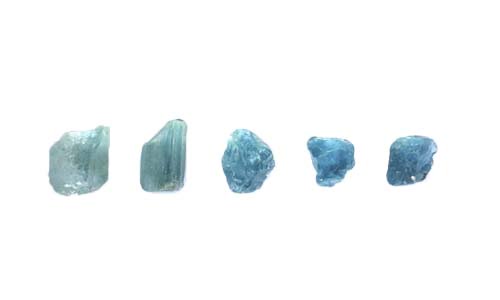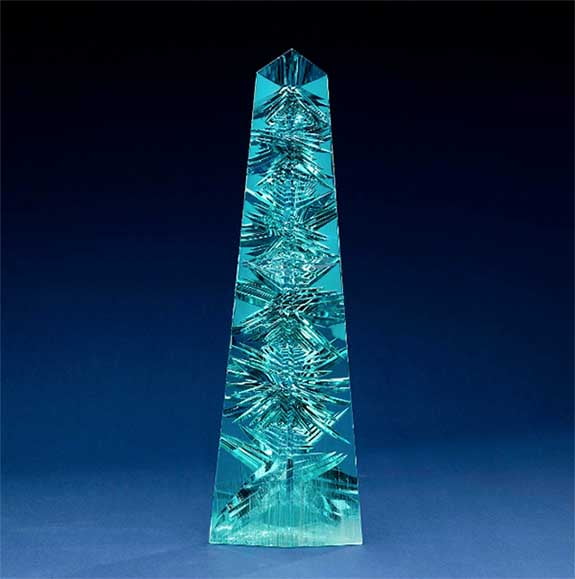March Birthstone: AQUAMARINE
Aquamarine is a greenish-blue to blue variety of the beryl family and the second most popular beryl species behind its green cousin emerald. In general, gemstones tend to inspire plenty of folklores and myths particularly during the age of the Greeks and Romans. Aquamarines are no exception. It has captured the imaginations of past ages with its magnificent calming pastel blue colour.
With its colour given by nature, it is no surprise that aquamarine will be associated with the sea. In fact, the name itself is translated from the Latin term “Aqua” and “Mare” which loosely carry the definition of “sea water”.
The colour range of aquamarine is somewhat narrow. Ranging from near-colourless pale blue, greenish blue, to medium-dark blue. However the blue of an aquamarine rarely matches a sapphire’s blue, even though there are discoveries of a darker blue beryl in the late 1910s which better known as Maxixe beryl (pronounced as mah-shee-shi).
Unfortunately, and fortunately for the aquamarine, when exposed to sunlight or heat the colour of the Maxixe tends to fade rapidly and eventually becomes brownish yellow. Although the colour can be restored by irradiation but it will fade just as quickly. Thus it was deemed unsuitable for jewellery use and now rarely seen by many.
Above: Different colour range of rough aquamarine (Visit https://www.thegemmuseumshop.com/products?search=aquamarine to start your collection of aquamarine)
Aquamarine are famously known for their large crystals formations and, often or not, free of inclusions. It boosts the gem market’s supply of aquamarine so much that even sizes as big as the setting permits, are regularly seen. Although there are many huge aquamarine crystals were found, most of them are likely to be cut into smaller pieces for jewellery purposes.
The largest aquamarine crystal ever recorded was weighed at a whopping 110kg with the height of only 48cm. Some other notable giant aquamarine crystals are as such: the Marta Rocha (37.7kg), the Urubu (33.2kg), and a 26kg aquamarine crystal that will be featured in our Gem Museum!
As for now, the title of largest faceted aquamarine crystal belongs to the Dom Pedro Aquamarine. The original size of the crystal was almost 1m tall and 45kg in weight. But it was then accidentally dropped and broken into few pieces. The largest piece of the bunch stands at approximately 60cm and 27kg. That rough was soon handed over to master fantasy cutter Bernd Munsteiner, dubbed the “Father of Fantasy Cut”, whom had an inspiration of transforming it into a wonder of a gem.
The entire plan of designing and sculpting took 10 months complete and this now lies at 35cm tall, roughly the length of an arm, and 10,363ct and it is on permanent display at the National Museum of Natural History in Washington D.C.
Above: The Dom Pedro Aquamarine. Photo credit: Donald E. Hurlbert
There are many sources where aquamarine can be mined. Locations such as Madagascar, Mozambique, Kenya, Australia, Nigeria, Zambia, USA, and China. But among them all, two most significant sources are Brazil and at the foothills of Pakistan. The renowned state of Brazil, Minas Gerais, is the center for gem quality aquamarine. It is the world’s most important source of aquamarine ever since mining began in the 1800s.
Regardless of the size of crystal, the crystals grow in a hexagonal manner. Meaning its atoms are structured in the hexagonal crystal system that exhibits a six-sided columnar crystal with flat termination, sometimes accompanied by pinacoids. On rare occasion beryl can grow with twelve sides. Its distinctive crystal feature allows gem hunters to accurately tell the type of mineral they have uncovered from the ground.
The best size and purity of aquamarine can usually be found in pegmatites. Pegmatites are an igneous rock that consists of almost entirely of crystals and common minerals such as quartz, feldspar, and mica.
All beryl has a basic chemical composition of beryllium, aluminum, and silicate. The purest of beryl is colourless. As for the much-loved pastel blue of aquamarine is caused by iron impurities. Due to the fact that iron is also responsible for creating yellow beryl, namely heliodor, the majority of the aquamarine crystal found contains a hint of green as a result from a simple colour mixology of blue and yellow.
Even so, heat treatment can easily remove the yellow or brownish tint, leaving an authentic aquamarine blue. So it is safe to assume that nearly all aquamarine found in jewellery are treated. The result of treatment is permanent.
Left: Rough aquamarine crystal; Right: Mermaid’s dream Aquamarine pendant (from Far East Gems & Jewellery)
Despite its treatment and all, aquamarine remains one of the top gemstones for jewellery due to its beauty and clarity. Though sometimes deemed affordable, aquamarine jewellery still appear in many big name auction houses, such as Christie’s and Bonhams, commanding premium prices. All in all, it’s a very cool stone to acquire. The beauty of aquamarine never cease to capture the attention of jewellery lovers.







I want to buy aquamarine gemstone sir plz help me out…
HI Sir,
You can also check out our e-shop for some gemstones. Otherwise, you can send us an email at info@fegj.com.sg to ask for more information.